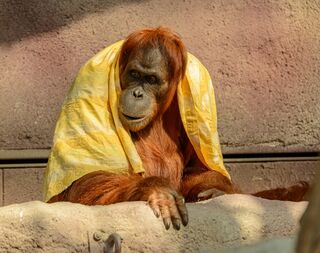Cognition
Showing the Alpha Male the Door
Read "Mama’s Last Hug" and say goodbye to the gorilla in the room.
Posted November 21, 2020 Reviewed by Matt Huston

Having already read so many of the wonderful books that Frans de Waal has written for the general public to share his insights from decades of studying our primate cousins, I hesitated slightly to add yet another to my collection when the book Mama’s Last Hug: Animal Emotions and What They Tell Us About Ourselves came out in 2018. Almost all of de Waal’s books have been filled with remarks about the social and emotional lives of apes and monkeys, so I wasn't sure what more I would learn from reading yet another of them. And I’m always a bit reluctant to succumb to rabid fandom, though I’ve been recommending de Waal to my students since his work was first recommended to me by a wise professional colleague some 20 years ago. Well, how wrong I was. Tour de force, this book! A corrective to much that is still wrong with our modern understanding of both ourselves and our animal cousins.
Thankfully, waiting may have made me savor this treat even more than I otherwise might have. Reading it has been a bit like eating that Halloween candy you've been hiding from yourself, awaiting a rainy day, and finding the treat all the more delightful for it. I’m afraid, though, that I’m not so likely to succeed at maintaining a stance short of fandom. This is an absolutely wonderful book, if you're ready to receive its wise and engaging mix of scientific reporting, intuitive insights, and powerful arguments about the history of the philosophical and scientific establishments’ thinking about our fellow animals as it's unfolded over the past few centuries.
Of course, any good prosecutor with access to the right set of my past posts here can easily convict me of being a biased judge. I became a behavioral economist in large part because I was convinced that the depiction of human decision-makers as hyper-rational, strictly selfish creatures—the required stance of mainstream academic economics prior to the 1980s—got the members of our species all wrong. Like de Waal, I had long ago become more a fan of Adam Smith’s Theory of the Moral Sentiments than of his The Wealth of Nations. And I've been devouring books by de Waal and by similarly disposed big thinkers like E. O. Wilson for a quarter-century with gusto.
So what can be new in Mama's Last Hug that wasn't already present in Good Natured, in Our Inner Ape, in The Age of Empathy, and other books by de Waal? Well, of course, there's the fact that the book was written in the midst of a presidency filled with simian theatrics, and that we're treated to de Waal's expert account of the remarkable similarities between the president's behaviors and body language and that of numerous chimpanzee and other ape males the author has known intimately over the course of his studies at several zoos and field stations. De Waal's detailed description of the president's difficulties debating a female challenger in 2016, and of the classic ape-like body language he displayed during a much-discussed debate, is priceless. So is a related, revealing discussion of unanticipated implications of the late John McCain's choice of an attractive young female running mate in 2008. The chapter about the social dynamics of power and the roles played by male and female group members is worth reading, even if you lack time for the rest of the book.
A more fundamental theme laid out more explicitly and powerfully in this than in other de Waal works is the argument for viewing the emotions in the social mammals and birds, on the one hand, and in humans, on the other, using a default assumption of continuity rather than of bright-line separation. He provides here a detailed account of how both philosophers and students of animal behavior have felt compelled, until recently, to avoid speaking of animal emotions in order to appear more scientific and to avoid anthropomorphizing animal behaviors. This put the scientists in the position of insisting on understanding less about the objects of their study than typical animal owners naturally intuit about their pets' similarities to themselves.
For philosophers such as Descartes to insist that only humans have souls and animals are at base machines was, it becomes clear, less of a truly scientific stance than a new way of reaffirming classical western philosophical beliefs about the uniqueness of humans relative to all other living things. Is it really so different, de Waal asks, to withhold belief that a dog experiences joy, affection, or shame than to adopt the solipsistic stance that one can know one's own self, only, to have any real "interiority"? And without going overboard towards denying that our language- and culture-enhanced world of ideas exhibits qualitative novelties within the animal kingdom, de Waal taps effectively into the work of neuroscientists like Michael Gazzaniga and Antonio Damasio to argue that human thought is as much a froth on the surface of the complex mix of emotions, intuitions and unconscious information processing that actually guide most of our actions as it is a rational driver separated from the body and controlling it with the aid of our vaunted ability to think and to draw on our cultural heritage—rich and unique among Earth's species as that heritage may be.
A third aspect of the book that I find especially worthwhile, as a behavioral economist who's directed most of his laboratory decision experiments at the question of human cooperation, is de Waal’s revisiting of the debate about which of our primate cousins we most resemble, a question on which he'd already written extensively in his book Our Inner Ape. To be sure, de Waal also provides fascinating material about less closely related species; for example, he shows that as distantly related a species as the capuchin monkeys of Central and South America lead emotionally and socially rich and complex lives that exhibit quite a few of the elemental social concerns that also mark the dynamics among close human interaction partners. And he shows how similar elements are visible in the social lives of some of the more cognitively sophisticated birds, and of dolphins, whales, wolves and elephants. But he has the most to say about the chimps and bonobos that, along with ourselves, descend from a common ancestor whose exact nature is unrecoverable from the mists of the six- or seven-million-year horizon at which the three of us began to branch apart.
De Waal’s discussion of how chimp societies are so strongly dominated by a coalition of males with an alpha at its apex, whereas no alpha male in a bonobo society can exercise power without the support of the group’s leading females, is reading worth pondering by any with a serious interest in the dynamics of power and gender among us humans. De Waal effectively stands his ground against critics who, he contends, treat the bonobo as an unimportant species that was turned into the “make love not war" ape primarily for its utility in 20th and 21st century humankind’s “culture wars.” As in Our Inner Ape, he provides considerable evidence that the differences between chimps and bonobos are real and striking, that there is no evidence that humans are any more closely related to the more aggressive chimpanzees than to the less aggressive and almost matriarchal bonobos. The wide array of behavioral styles visible in human interactions—from war, political strife, cut-throat economic competition and gender and racial conflict, on the one hand, to cooperation and self-sacrifice, admiration for peace-makers, and attraction to “the better angels of our nature,” on the other—are among the many observations suggesting our equal proximity to the two (though genetic analysis speaks more directly and scientifically to the matter).
Are there really lessons to be drawn for human society from the study of apes? I find it hard to read de Waal without concluding that there are indeed such lessons. De Waal doubtless began his studies being a bit more attracted to bonobos than to chimps due to a genial nature and the roseate cultural influence of the idealistic movements for social change so prevalent on university campuses in Western Europe and North America in the late 1960s. So did I. But he’s also a hard-nosed scientist looking at the data he's been building up and sifting through over his long career, and he's able to see and to articulate clearly the biases and naïveté of his generational starting point.
There’s nothing naïve or contrary to the spirit of science in wanting to learn what we can from the world around us and apply it to find ways of reducing the likelihood of making our world more hell than heaven by unwise social policies and projects. You could do much worse than to find a few hours to read this book with an open mind, then roll up your sleeves and go back to the work of attempting to bring a little less strife and a little more love into your world. And you’ll be doing it with a little more wisdom, with a little more humility, and with a lot more knowledge.
References
Frans de Waal, Mama's Last Hug: Animal Emotions and What They Tell Us about Ourselves.




